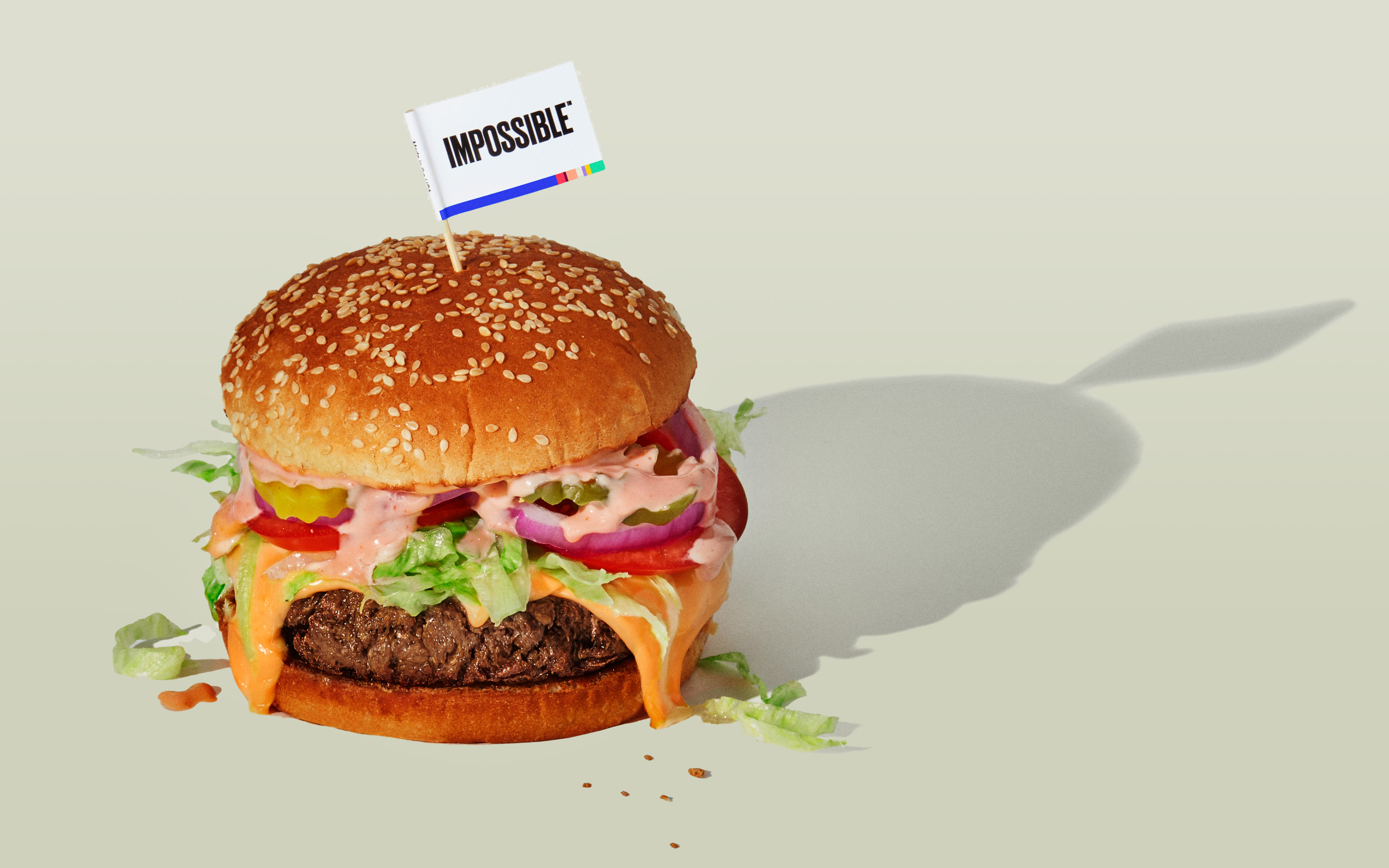Bill Gates: Rich nations should shift entirely to synthetic beef
We spoke to the Microsoft cofounder about his new book, the limits of his optimism, the tech breakthroughs and energy policies we need—and how his thinking on climate change has evolved.

In his new book, How to Avoid a Climate Disaster, Bill Gates lays out what it will really take to eliminate the greenhouse-gas emissions driving climate change.
The Microsoft cofounder, who is now cochair of the Bill and Melinda Gates Foundation and chair of the investment fund Breakthrough Energy Ventures, sticks to his past argument that we’ll need numerous energy breakthroughs to have any hope of cleaning up all parts of the economy and the poorest parts of the world. The bulk of the book surveys the technologies needed to slash emissions in “hard to solve” sectors like steel, cement, and agriculture.
He stresses that innovation will make it cheaper and more politically feasible for every nation to cut or prevent emissions. But Gates also answers some of the criticisms that his climate prescriptions have been overly focused on “energy miracles” at the expense of aggressive government policies.
The closing chapters of the book lay out long lists of ways that nations could accelerate the shift, including high carbon prices, clean electricity standards, clean fuel standards, and far more funding for research and development. Gates calls for governments to quintuple their annual investments in clean tech, which would add up to $35 billion in the US.
Gates describes himself as an optimist, but it’s a constrained type of optimism. He dedicates an entire chapter to describing just how hard a problem climate change is to address. And while he consistently says we can develop the necessary technology and we can avoid a disaster; it’s less clear how hopeful he is that we will.
I spoke to Gates in December about his new book, the limits of his optimism, and how his thinking on climate change has evolved.
Gates is an investor either personally or through Breakthrough Energy Ventures in several of the companies he mentions below, including Beyond Meats, Carbon Engineering, Impossible Foods, Memphis Meats, and Pivot Bio. This interview has been edited for space and clarity.
Q: In the past, it seemed you would distance yourself from the policy side of climate change, which had led to some criticisms that you are overly focused on innovation. Was there a shift in your thinking, or was it a deliberate choice to lay out the policy side in your book?
A: No, that’s absolutely fair. In general, if you can do innovation without having to get involved in the political issues, I always prefer that. It’s more natural for me to find a great scientist and back multiple approaches.
But the reason I smile when you say it is because in our global health work, there’s a whole decade where I’m recognizing that to have the impact we want, we’re going to have to work with both the donor governments in a very deep way and the recipient governments that actually create these primary health-care systems.
And my naïve view at the beginning had been “Hey, I’ll just create a malaria vaccine and other people will worry about getting that out into the field.” That clearly wasn’t a good idea. I realized that for a lot of these diseases, including diarrhea and pneumonia, there actually were vaccines. And it was more of a political challenge in getting the marginal pricing and the funds raised and the vaccine coverage up, not the scientific piece.
Here, there’s no doubt you need to get government policy in a huge way. Take things like clean steel: it doesn’t have other benefits. There’s no market demand for clean steel. Even carbon taxes at low costs per ton aren’t enough to get clean steel on the learning curve. You need like a $300-a-ton type of carbon tax. And so to get that sector going, you need to do some basic R&D, and you need to actually start having purchase requirements or funds set aside to pay that premium, both from government and perhaps companies and individuals as well.
But, you know, we need a lot of countries, not just a few, to engage in this.
Q: How do you feel about our chances of making real political progress, particularly in in the US, in the moment we find ourselves in?
A: I am optimistic. Biden being elected is a good thing. Even more encouraging is that if you poll young voters, millennials, both who identify as Republican and Democrats, the interest in this issue is very high. And they’re the ones who will be alive when the world either is massively suffering from these problems or is not, depending on what gets done. So there is political will.
But there’s a lot of interplay [between politics and innovation]. If you try and do this with brute force, just paying the current premiums for clean technology, the economic cost is gigantic and the economic displacement is gigantic. And so I don’t believe that even a rich country will do this by brute force.
But in the near term, you may be able to get tens of billions of dollars for the innovation agenda. Republicans often like innovation.
I’m asking for something that’s like the size of the National Institutes of Health budget. I feel [it’s politically feasible] because it creates high-paying jobs and because it answers the question of—well, if the US gets rid of its 14% [of global emissions], big deal: what about the growing percent that comes from India as it’s providing basic capabilities to its citizens?
I just imagine a phone call to the Indians in 2050 where you say, Please, please, build half as much shelter because of the green premium [for clean cement and steel]. And they’re like, What? We didn’t cause these emissions.
Innovation is the only way to [reduce those price premiums].
Q: You’ve said a couple of times you’re optimistic, and that’s sort of famously your position on these things. But of course, optimism is a relative term. Do you think we can realistically hold warming to or below a 2 °C increase at this point?
A: That would require us to get the policy right, to get many, many countries involved, and to be lucky on quite a few of the technological advances. That’s pretty much a best case. Anything better than that is not at all realistic, and there are days when even that doesn’t seem realistic.
It’s not out of the question, but it requires awfully good progress. Even something like, do we get [an energy] storage miracle or not? We can’t make ourselves dependent on that. Batteries today can’t, within a factor of 20, store for the seasonal variation that you get [from intermittent sources like wind and solar]. We just don’t make enough batteries; it would be way too expensive. So we have to have other paths—like fission or fusion—that can give us that reliable source of electricity, which we’ll be even more dependent on than ever.

Q: In the book you cover a broad array of hard-to-solve sectors. The one I still have the hardest time with, in terms of fully addressing it, is food. The scale is massive. We’ve barely begun. We fundamentally don’t have replacements that completely eliminate the highly potent emissions from burping livestock and fertilizer. How hopeful are you about agriculture?
A: There are [companies], including one in the [Breakthrough Energy Ventures] portfolio called Pivot Bio, that significantly reduce the amount of fertilizer you need. There are advances in seeds, including seeds that do what legumes do: that is, they’re able to [convert nitrogen in the soil into compounds that plants can use] biologically. But the ability to improve photosynthesis and to improve nitrogen fixation is one of the most underinvested things.
In terms of livestock, it’s very difficult. There are all the things where they feed them different food, like there’s this one compound that gives you a 20% reduction [in methane emissions]. But sadly, those bacteria [in their digestive system that produce methane] are a necessary part of breaking down the grass. And so I don’t know if there’ll be some natural approach there. I’m afraid the synthetic [protein alternatives like plant-based burgers] will be required for at least the beef thing.
Now the people like Memphis Meats who do it at a cellular level—I don’t know that that will ever be economical. But Impossible and Beyond have a road map, a quality road map and a cost road map, that makes them totally competitive.
As for scale today, they don’t represent 1% of the meat in the world, but they’re on their way. And Breakthrough Energy has four different investments in this space for making the ingredients very efficiently. So yeah, this is the one area where my optimism five years ago would have made this, steel, and cement the three hardest.
Now I’ve said I can actually see a path. But you’re right that saying to people, “You can’t have cows anymore”—talk about a politically unpopular approach to things.
Q: Do you think plant-based and lab-grown meats could be the full solution to the protein problem globally, even in poor nations? Or do you think it’s going to be some fraction because of the things you’re talking about, the cultural love of a hamburger and the way livestock is so central to economies around the world?
A: For Africa and other poor countries, we’ll have to use animal genetics to dramatically raise the amount of beef per emissions for them. Weirdly, the US livestock, because they’re so productive, the emissions per pound of beef are dramatically less than emissions per pound in Africa. And as part of the [Bill and Melinda Gates] Foundation’s work, we’re taking the benefit of the African livestock, which means they can survive in heat, and crossing in the monstrous productivity both on the meat side and the milk side of the elite US beef lines.
So no, I don’t think the poorest 80 countries will be eating synthetic meat. I do think all rich countries should move to 100% synthetic beef. You can get used to the taste difference, and the claim is they’re going to make it taste even better over time. Eventually, that green premium is modest enough that you can sort of change the [behavior of] people or use regulation to totally shift the demand.
So for meat in the middle-income-and-above countries, I do think it’s possible. But it’s one of those ones where, wow, you have to track it every year and see, and the politics [are challenging]. There are all these bills that say it’s got to be called, basically, lab garbage to be sold. They don’t want us to use the beef label.
Q: You talk a lot in the book about the importance of carbon-removal technologies, like direct air capture. You also did come out and say that planting trees as a climate solution is overblown. What’s your reaction to things like the Trillion Trees Initiative and the large number of corporations announcing plans to achieve negative emissions at least in part through reforestation and offsets?
A: [To offset] my own emissions, I’ve bought clean aviation fuel. I’ve paid to replace natural-gas heating in low-income housing projects with electric heat pumps—where I pay the capital cost premium and they get the benefit of the lower monthly bill. And I’ve sent money to Climeworks [a Switzerland-based company that removes carbon dioxide from the air and stores it permanently underground].
For the carbon emissions I’ve done—and I’ve gotten rid of more than what I emit—it comes out to $400 a ton.
Any of these schemes that claim to remove carbon for $5, $15, $30 a ton? Just look at it.
The idea that there are all these places where there’s plenty of good soil and plenty of good water and just accidentally, the trees didn’t grow there—and if you plant a tree there, it’s going to be there for thousands of years—[is wrong].
The lack of validity for most of that tree planting is one of those things where this movement is not an honest movement yet. It doesn’t know how to measure truth yet. There are all sorts of hokey things that allow people to use their PR budgets to buy virtue but aren’t really having the impact. And we’ll get smarter over time about what is a real offset.

So no, most of those offset things don’t stand up. The offset thing that we think will stand up is if you gather money from companies and consumers to bootstrap the market for clean steel and clean cement. Because of the learning-curve benefits there, putting your money into that, instead of on tree planting, is catalytic in nature and will make a contribution. We need some mix of government, company, and individual money to drive those markets.
Q: I do have to ask this: Microsoft is in the process of trying to eliminate its entire historic emissions, and there was a Bloomberg article that had a figure in there that I was a little surprised by. The company apparently wants to do it at $20 a ton? Do you think we can achieve reliable permanent carbon removal for $20 a ton eventually?
A: Very unlikely.
I mean, if you’d asked me 10 years ago how cheap solar panels would become, I would have been wrong. That went further than anyone expected.
Science is mysterious, and saying that science can do X or can’t do X is kind of a fool’s game. In many cases, it’s done things that no one would have predicted.
But even the liquid process, which is Carbon Engineering’s approach, will have a very tough time getting to $100 a ton.
With all these things, you have capital costs and you have energy costs. So getting to $20 a ton is very unlikely. There are a lot of current offset programs that claim they’re doing that, and that needs a lot of auditing because to eliminate carbon, you have to keep it out of the atmosphere for the full 10,000-year half-life. Most people have a hard time economically costing out 10,000 years of costs. Believe me, these tree guys make sure that if it burns down, they find another magic place where no tree has ever grown, to replant.
But it’s not to say that there aren’t a few places you can plant trees, or that a few of these offset things will work, like plugging certain methane leaks—that’s a high payback. We should use regulations; we should go fund those things.
Deep Dive
Climate change and energy
The problem with plug-in hybrids? Their drivers.
Plug-in hybrids are often sold as a transition to EVs, but new data from Europe shows we’re still underestimating the emissions they produce.
Harvard has halted its long-planned atmospheric geoengineering experiment
The decision follows years of controversy and the departure of one of the program’s key researchers.
Why hydrogen is losing the race to power cleaner cars
Batteries are dominating zero-emissions vehicles, and the fuel has better uses elsewhere.
Decarbonizing production of energy is a quick win
Clean technologies, including carbon management platforms, enable the global energy industry to play a crucial role in the transition to net zero.
Stay connected
Get the latest updates from
MIT Technology Review
Discover special offers, top stories, upcoming events, and more.